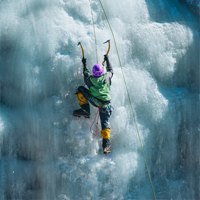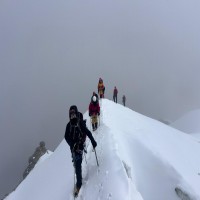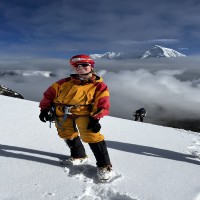-
Destination: Nepal
-
Trip Difficulty: Moderate
-
Transport: As Per Itinerary
-
Food: As Per Itinerary
-
Accommodation: Lodge + Camping
-
Group Size: 1-16
-
Max Elevation: 5800m/19025ft
Himalayan Mountaineering Course (Level I)
Overview:
"Himalayan Mountaineering Course: Where Adventure Begins"
A Himalayan Mountaineering Course designed for beginners who want to step into mountaineering in the Himalayas or explore mountaineering adventures with a set of skills. The Himalayan Mountaineering Course is a 20-day training program executed under the supervision of the IFMGA/NNMGA guide. The course incorporates learning various mountaineering skills like rock, ice, and snow climbing, along with negotiating glacial terrain. The course enables trainees to learn and apply multiple mountain disciplines such as mountain navigation, leadership skills, high-altitude physiology, and technical features of snow and avalanches, along with an attempt to scale around 6,000 m mountain at the end of the training.
The climb will be subject to the weather, climbing conditions, and other contingencies. Yet there are numerous options available for the climb; Naya Khang, Scout Peak, and Tsorku Peak can be alternatives.
This training course, however, requires a sound level of fitness.
This 20-day course is suitable for people who can walk at least 5-7 km per day carrying a 60-liter backpack. And as long as you have an average level of fitness and a positive attitude and determination, this trip is definitely for you. Ideally, potential participants exercise and jog regularly in the months before the course to ensure a good level of fitness and strength. Get in touch now to reserve your place at the magnificent Naya Khang Mountain in the Langtang region of the Himalayas on a 20-day technical mountaineering level I course.
Useful Information
Seasonality
-
Spring/Autumn:
-
Spring in Nepal refers to March, April and May months
-
Autumn season refers to mid-September to mid-November.
-
These are the best times to visit Nepal, as the weather is clear, the views are mesmerizing and there are little or no weather hazards
-
In these seasons, the training is executed in Scout Peak, Langtang region
-
Winter
-
Winter in Nepal refers to December, January and February
-
Winter training is for the tough and dedicated.
-
This training prepares for bigger challenges such as 8000er climbs and hard adventures in the Himalaya
-
Training is executed in the Langtang region of Nepal during winter.
Equipment List
Layering
We believe that all Mountain Travel Equipment should follow two simple tenets: Lightweight and Functional. Lightweight equipment increases your chance of success and helps make you more comfortable. Functional equipment determines how warm, dry and safe you will be, so always choose equipment that is of god quality, is dependable, and is adaptable to a variety of extreme conditions.
Clothing impacts not only your comfort but also yours safety, always be critical of the quality and the proper fit of your clothing. Cotton clothing must be avoided because it dries very slowly and is a poor insulator when wet. Instead, choose wool or synthetic fabrics that wick the sweat and moisture away from your skin.
Our recommended clothing system has four layers.
- Base layer: manages moisture and wicks perspiration away from your skin. (Polypro, capelin)
- Soft shell: should be a durable, comfortable, and insulating and wind/water resistant layer that breathes well. The main soft sell fabrics are polar Tec wind pro, Gore wind stopper N2S and each clothing manufacturer has their own. 200 weight fleeces can be substituted for our soft shell recommendations but is not as versatile on how it may be used when layering.
- Hard shell: windproof, waterproof and breathable. (e.g. Gore-Tex, or similar)
- Insulating Layer: Should be down-fill or synthetic-fill and fit over all layers. (e.g. down, primaloft or polar guard)
These four layers are usually sufficient for most people, but if you tend to be colder bring one extra medium- layer that would be ideal for extra warmth around camp, such as a vest. When deciding what to pack, remember to bring enough clothes and accessories to insure your safety and comfort, while not over- burdening yourself with items you probably won’t use.
Only Technical Climbing Gear
1-Alpine Climbing Harness (must be adjustable leg loops & fit over all clothing.
3-Locking carabineers
2- Regular carabineers
1-Normel Ice axe (if you have Ice climbing tools you can bring that also)
1 pair- Plastic Mountaineering Boots/or double leather hybrid boots
1 pair- Crampons (must be fit to plastic boots prior to trip
1-Helmet
1-Tape sling (120cm)
1-Assistant rope about 6-7 MM diameter about 4 meters long.
1 pair- Gaiters
1-Jumar (Ascender)
1-Belay Device any one
2-Ice Screw (Black Diamond)
1 or pair Adjustable trekking poles
1 pair Rock shoes (if you have)
Physiological Adaptations to Altitude
Increased breathing Rate: one adaptation to high altitude hypoxia is an increase in the rare of breathing. After ascending to high altitude, a climbers breathing rate continues to increase for several days. As this occurs, dissolved carbon dioxide in the bloodstream decreases (as carbon dioxide is exhaled).
Dieresis: another normal adaption to high altitude hypoxia is that the kidneys send more water on to the bladder as urine, ridding the body of more fluid. This dieresis makes the blood slightly thicker. This change begins promptly upon ascent and continues for several of red blood cells in as effort to increase oxygen carrying capacity.
Insomnia: the ability to sleep soundly deteriorates at high altitude. Most mountaineers have insomnia at altitude, waking up more often during the night and getting less deep sleep. Commonly, an irregular breathing rhythm appears during sleep and sometimes during wakefulness, too. There are periods of apnea (no breathing) interspersed with periods of hyperventilation (this alternating rhythm is known as Cheyne-Stokes respiration). The low carbon dioxide content of the blood appears to drive this odd change in breathing. A Small dose (one-quarter tablet) of acetazolamide (Dimox) at bedtime decreases Cheyne - Stokes respiration and may aid your sleep.
Acute Mountain Sickness (AMS)
For Acclimatization prevention can use Dimox:
The medicines can be used to deal with altitude related health problems; ask your physician about the appropriateness of such drugs for your situation. For example, some mountaineers use acetazolamide the night before or morning of the ascent and through the first 48 hours at high altitude in order to prevent AMS or block its recurrence. Potential problems caused by this medication are tingling of extremities, ringing in the ears, nausea, frequent urination, and a change in the sense of taste. Individuals with sulfa allergies must be careful, as 6-8 percent will have an allergic reaction to Dimox. It is better to test this possibility at home rather than in the mountains. Dimox does appear to be effective in preventing and treating AMS as well as the breathing changes brought on by high Altitude.
TIPS for Acclimatization
These are rough guidelines for controlling the rate of ascent to allow your body to acclimatize;
- Above 10,000 feet (about 3000 Meters) limit increases in sleeping elevation to about 1,000 to 1,500 feet (300 to about 500 meters) per night
- Two or three times a week, allow an additional night at the same elevation as the night before.

















